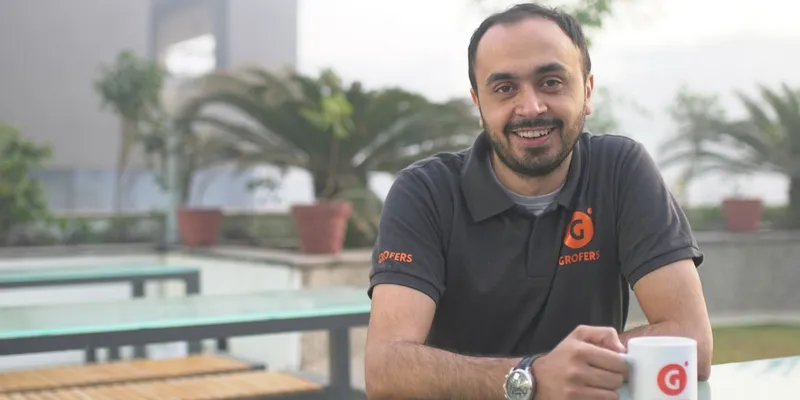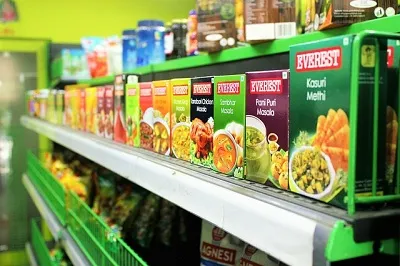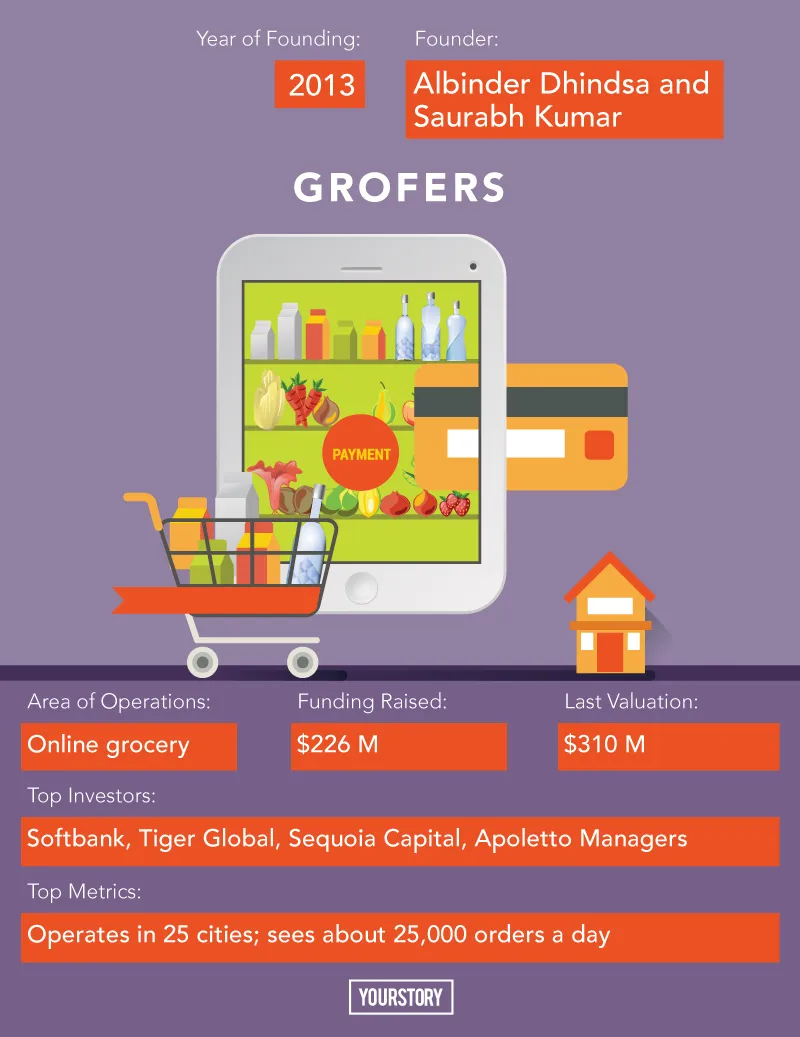How Grofers got the online grocery game right and won Rs 400 crore from SoftBank
Grofers co-founder and CEO Albinder Dhindsa says the turnaround has been scripted by focusing on insights into consumer behaviour, and a bespoke supply chain model.

Pretty much every ecommerce company in India have been built on the belief that disposable income is on the rise among middle-class consumers. Every single ecommerce platform I have spoken to, in fact, asserts that the aspiring middle class is more active when it comes to internet shopping. This theory has given birth to many online fashion and lifestyle platforms.
But a reality check for more essential categories like grocery shows that this is true only for a miniscule part of the population. After all, the country with a 1.3 billion population still has only 400 million smartphone users, and less than 100 million active online shoppers.
Gurgaon-based online grocery platform Grofers has made this realisation their USP over the past year, in its effort to become the market leader in the sector. According to Grofers co-founder and CEO Albinder Dhindsa, the Indian customer is not as affluent as s/he is believed to be. “We have minimal disposable income. Our GDP per capita is still low; a big chunk of income is spent on grocery,” he reminds me.
Whether Grofers has toppled over BigBasket, the market leader so far, is a matter of debate. But it is undeniable that Grofers, which had hit a stagnant phase some time ago, has managed to rebuild itself in the past one year.
In fact, Grofers claims that they have registered a single day sale crossing Rs.7.8 crore on 1st April 2018, a fivefold growth over 1st April 2017.
In an exclusive chat with YourStory, Albinder spoke about how Grofers has pushed itself, building private label with better insights into consumer behaviour, and a bespoke supply chain model.
SoftBank’s gift
Just a few weeks ago, Grofers raised Rs 400 crore (about $62 million) in a Series E round from its existing investors SoftBank and Tiger Global Management, making the total funding of the five-year-old company $226 million.
From ending operations in several Tier II and Tier III cities to shutting down its express delivery service, Grofers has seen some tough times. Many industry observers even predicted Grofers’ fall at one point. So how did this latest funding happen?
Albinder tells me, “Over the past one year, we have been putting our heads down to grow our business. Now we have the largest market share. There was no single USP. It was a lot of things done for the long run. We have had 10x growth in the customer segment in 30 months.”
Grofers is now profitable only in Delhi.
“We will be investing in supply chain for getting products to the consumer and operationally break even in the next two years. Now that we do not provide express delivery, we focus on next-day delivery (minimum 20 hours, average 28 hours for delivery),” Albinder says.
But Grofers started off as an express delivery company. Isn’t this a huge change? It’s one which was essential, it seems. Albinder confesses that they could not provide value without a costly supply chain, which would hurt the customer.
“With next-day delivery, we are the biggest grocery company in the country. For our customer, which is India’s middle class, getting their groceries the next day is fine if it saves them Rs 20 on delivery costs,” he elaborates.
Quality at the right price matters more in grocery, offline and online. Discounts do not hold significance in this category. Many bigger brands also deal with Grofers directly with no middlemen, which ultimately benefits the customer.
Building loyalty
Launched in January, Grofers’ membership/subscription-based service Smart Bachat Club crossed 50,000 subscribers in just two weeks, and 1,50,000 in 90 days of the launch. Members of the club would be able to shop for their daily groceries by paying as low as wholesale prices.
Albinder explains what inspired this programme.
Grofers had got a decent scale by September of about Rs 50 Crore (in monthly GMV). They started working on a loyalty programme in August - only for cities where Grofers does delivery themselves. “We looked at different models to give the right proposition to our customers. Our subscription model, unlike Amazon Prime, is modelled after Costco in the US, where a club membership signs you up for grocery,” Albinder says.

Apparently, Grofers’ research found that loyalty is not something the user was looking for. Albinder elaborates, “Mostly homemakers are in charge of grocery, and they were not comfortable with loyalty programmes. But they will buy from you every month if you provide them value and save them a trip to the wholesale market. So we decided on a membership programme where members get a better price. It gives customer repetition.”
Since 65 percent of Grofers’ customers are families, it is not marketing campaigns, but word of mouth that brings in new customers. In fact, 12% of their customers (non-working women) are transacting online for the first time.
With 12 percent of new users on the platform being first-time online buyers, it is interesting to note that affordable data connections are driving the uptake of online shopping amongst women. Jio has also accelerated the adoption, as a large user base of almost 43% is coming from users who are using Jio.
Currently, Grofers' customer base is 75 percent women customers, as opposed to 69 percent men over last year.
Targets set
In January 2018, Grofers crossed Rs.100 crore monthly GMV. Their target for December 2018 is Rs 200 crore per month. Albinder claims that they are growing 15 percent monthly in all cities they are present in.
“Delhi is our best market where we are the biggest player. The city gives 45 percent of overall business; we are now growing fast in Mumbai, Pune and Bangalore,” he adds.
Since grocery demands a bespoke supply chain for expansion, they want to build it themselves. “There is still work left to do in the cities we are already present in. We are trying to upgrade the 25 warehouses. In Delhi, we have 175 lakh square foot warehousing which we are upgrading 3.5x,” Albinder says.
In FY2019, market share is more important for Grofers than expansion. Albinder is clear about turning profitable in key markets first before expanding with supply chain and warehouse in new markets. “Once we reach 10x scale, we can do way more automation in warehousing than we currently can,” he adds.
Expanding the market
India’s online grocery market is now worth $1 billion – Rs 6,500 crore. Bangalore-based player BigBasket has had GMV of over Rs 2,000 crore in FY2018, while Grofers crossed Rs 1,000 crore. But the competition is not just between these two.
People do not spend on fashion or gadgets as much as they do on grocery. So horizontal ecommerce leaders Flipkart and Amazon India also want to tap the market.
But Albinder does not seem intimidated. He believes that more competition will help raise awareness that you can buy grocery online. He adds that the risk for Amazon and Flipkart in grocery is that they have already run out of premium customers. Albinder believes that while they can convert existing customers to buying grocery on their platform, they cannot acquire more customers.
On the other hand, almost 50 percent of Grofers’ orders come from sectors of the city demarcated as high population density, low income, in Delhi NCR, which lack organized retail. While a lot of factors influencing the presence of organized grocery retailers in these areas including real estate availability and cost being primary, customers are turning to online grocery shopping for better solutions for their monthly purchases rather than just using the local Kirana.
What did Grofers get right (and Amazon did not)?
The short answer is: its focus on building value for middle-class customers.
The key to winning online grocery is finding what the customer wants and offering it- with focus on one segment of consumers. Each player has to choose the kind of customer they want to go after.
“What matters is finding the right product for the masses. Wholesale markets are still preferred by many customers because they serve customers’ needs at the right price points,” says Albinder, adding that a value proposition is more significant than marketing in reaching out to the customer.
Grofers does not include the premium end of the customer base in their target group as, according to Albinder, those in a higher income bracket have different taste in grocery, which needs a different (assortment-oriented) supply chain with lot more items and longer shelf life.
“Masses care about price points, quality, consistency. Our assortment is also meant for them,” Albinder explains. Of course, this means they are always battling time and expiry date issues; so inventory has to move quickly. Albinder claims that Grofers has still grown 4x in the last 12 months.
“We track what price point homemakers in different cities look for in different products. We engage with the customers to find out if we are providing them all, and whether we are selling it at a price point the customer can afford,” he adds.
Grofers is aggressive on reaching a certain scale quickly. “Scale (at the product level) matters the most; it reduces the cost. If I can sell ghee worth Rs 5 crore, I can procure in bulk and sell cheaper (because sourcing cost is lesser),” Albinder says.
Expanding their business is essentially an online-only strategy for Grofers. Last year, they launched stalls at OYO Rooms’ hotels on a trial mode. But Albinder agrees that offline channels do not work for their business model.
Building supply for demand
Targeting a particular consumer segment means catering to particular demands too. In the southern market in Delhi, many people buy unbranded ghee as it is Rs 50 cheaper than the branded ones. Grofers was already selling Amul and Patanjali ghee; but now they sell unbranded ghee too with better price, quality, packaging, and value proposition. “Such exclusive private labels and smaller brands are very attractive to the customer for a comfortable price point,” Albinder says.
Currently Grofers has more than 500 regional economy brands, a number expected to double by the end of 2018. Private brands contribute 35 percent to Grofers’ overall GMV, which is expected to grow with higher customer engagement to understand their expectations.
The company plans to extend their product ranges in categories like staple commodities, fresh produce, home furnishing, general merchandise, breakfast cereals, home care, paper disposables, puja needs, snacks, processed foods, beverages, personal care products etc. - altogether more than 300 product launches across more than 1000 SKUs by the end of 2018.
Buying and selling
Grofers’ buying size is higher than general trade because of their larger storage capacities, with a frequent supply cycle. It requires better TAT (turn-around time) on fill rates.
“We buy 3-4 lakh SKUs per day. While traditional stores fill rate is 60 percent, ours is as high as 65 percent. We work on mutually benefitting commitment with our vendors. Payments are done on time, and with efficient forecasting of business to distribution, vendors are able to better plan their inventory. Our bulk quantity purchase lessens the logistics manoeuvre and prevents damage,” Albinder claims.

Currently, Grofers sells about 5,000 SKUs in every city, with 400 sub-categories.
Intricacies of supply chain
Grofers has 270 active L2s, but an intricate supply chain that makes the process smoother. (L2 brands are those that are proven to do well in e-tail.)
Albinder explains, “We have built an in-house order allocation system that decides the supply channel for orders – Grofers’ own fleet, third-party logistics, or store delivery channel, whichever is the best fit based on capability and past performance.”
Each sub-channel is optimised for deliveries. The inhouse logistics (Grofers Go) optimises allocated orders using a "Route Planner", which clubs orders in same locality for a given slot. This is then distributed to vans/bikes based on their capacities per slot, creating a daily delivery map for each with minimum travel distance. Grofers currently has 1,500 delivery executives.
Even the grade of crate to be used for each order is pre-decided by the in-house Warehouse Management System (WMS) based on order volume, to minimise space wastage. Grofers has custom delivery vans to maximise space utilisation.
Keeping it fresh
Fresh fruits and vegetables are an inevitable part of your grocery bag. Grofers sources fruits and vegetables directly from the farmers, eliminating middlemen. If they are harvested today, they are delivered tomorrow with Grofers’ own supply chain.
But building a supply chain for fresh fruits and vegetables demands attention to detail.
In a cold supply chain, the challenge is to ensure that product reaches in the right state at the customer’s doorstep. Cold storage items sensitive to temperature are not kept outside the cold room during operational processes like billing, picking, and during transitions of receiving stocks. The cold room maintains apt temperature as per the requirement of each SKU.
In fact, cold products are billed separately, packed in separate boxes in the last-mile chain. Once the product reaches the aggregation centres, their system ensures these products don't stay at ambient temperature for long.

Currently, fruits and vegetables provide 10 percent of overall revenue by value, with 35 percent customers buying daily. Grofers is investing in scaling up the sourcing part with more farmers.
What next?
According to Albinder, FY2018 was Grofers’ best year so far. Grofers closed March 2018 with around Rs 120 crore in revenue. “We have had 4x growth in revenue in one year. Since the last time we raised funding, it has become 8x,” he says.
However, the most recent funding was done with 20 percent lesser valuation for Grofers – at $310 million. But this does not seem to bother Albinder. “Exit valuation or IPO is all that matters. Currently, valuation is not our focus,” he says.
There is no complacency though. Grofers’ next step is to understand the potential of Tier II and III towns. “We have just begun understanding their expectations. The consumer behaviour is not very different in middle India. But it is a challenge to extend the supply chain at lower costs to these places,” Albinder says.
Yet, isn’t there another option? Grofers was reportedly in talks with BigBasket for a merger, and with a common investor in Tiger Global, is there a possible acquisition by Flipkart? Albinder says these are just hypothetical scenarios. “We want to do much better. That’s where our focus is,” he signs off.







